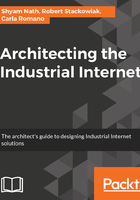
Data management
IIoT solutions collect potentially huge volumes of data, typically at high velocity, and can also include data from traditional or legacy systems. This integration of data can consist of time series data from sensors and device data, including logs, and structured and unstructured data. Structured data is typically data from traditional enterprise or departmental software applications with known predefined data structures, or schemas. Unstructured data includes data with unknown or irregular and varying structures. These can include text from social media and digital images. Integrating these data sources can be challenging, but also can provide the basis for more effective monitoring, identification of problem areas, targeted and timely responses, and more effective analysis and decision making.
IIoT data management activities include the following:
- Reduction and analytics
- Publish and subscribe
- Query
- Storage, persistence, and retrieval
- Integration
- Description and presence
- Data framework
- Rights management
Here, the usage and functional viewpoints should provide guidance. IIoT data management needs to provide the users with information, analysis, and cross-functional insights that would not have been available in traditional applications where data may be stored in functional silos and unavailable for cross-functional analysis.